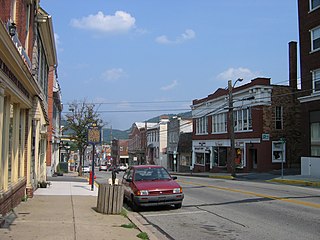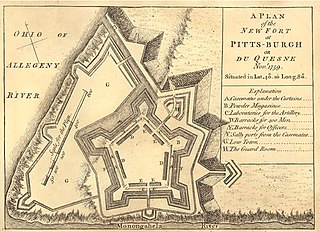
Bedford is a borough and spa town in and the county seat of Bedford County in the U.S. state of Pennsylvania. It is located 102 miles (164 km) west of Harrisburg, the state capital, and 107 miles (172 km) east of Pittsburgh. Bedford's population was 2,861 at the 2020 census.

Lebanon is a city in and the county seat of Lebanon County, Pennsylvania, United States. The population was 26,814 at the 2020 census.

Palmyra is a borough in Lebanon County, Pennsylvania, United States. It is part of the Lebanon, Pennsylvania Metropolitan statistical area. The population was 7,807 at the 2020 census.

Nippenose Township is a township in Lycoming County, Pennsylvania, United States. The population was 662 at the 2020 census. It is part of the Williamsport, Pennsylvania Metropolitan Statistical Area.

Indiana limestone — also known as Bedford limestone in the building trade — has long been an economically important building material, particularly for monumental public structures. Indiana limestone is a more common term for Salem Limestone, a geological formation primarily quarried in south central Indiana, USA, between the cities of Bloomington and Bedford. It has been called the best quarried limestone in the United States.

The Allen County Courthouse is located at the block surrounded by Clinton/Calhoun/Main/Berry Streets in downtown Fort Wayne, Indiana, the county seat of Allen County. Built between 1897 and 1902, it is a nationally significant example of Beaux-Arts architecture. It was listed on the National Register of Historic Places in 1976 and was designated a National Historic Landmark on July 31, 2003.

Fort de Chartres was a French fortification first built in 1720 on the east bank of the Mississippi River in present-day Illinois. It was used as the administrative center for the province, which was part of New France. Due generally to river floods, the fort was rebuilt twice, the last time in limestone in the 1750s in the era of French colonial control over Louisiana and the Illinois Country.

Fort Pitt was a fort built by British forces between 1759 and 1761 during the French and Indian War at the confluence of the Monongahela and Allegheny rivers, where the Ohio River is formed in western Pennsylvania. It was near the site of Fort Duquesne, a French colonial fort built in 1754 as tensions increased between Great Britain and France in both Europe and North America. The French destroyed Fort Duquesne in 1758 when they retreated under British attack.

Breezewood is an unincorporated town in East Providence Township, Bedford County in south-central Pennsylvania, United States.

Fort Augusta was a stronghold in Northumberland County, Pennsylvania, in the upper Susquehanna Valley from the time of the French and Indian War to the close of the American Revolution.

The Conrad Weiser Homestead was the home of Johann Conrad Weiser, who enlisted the Iroquois on the British side in the French and Indian War. The home is located near Womelsdorf, Berks County, Pennsylvania in the United States. A designated National Historic Landmark, it is currently administered as a historic house museum by the Pennsylvania Historical and Museum Commission. The historic site was established in 1923 to preserve an example of a colonial homestead and to honor Weiser, an important figure in the settlement of the colonial frontier.

Conrad Weiser, born Johann Conrad Weiser, Jr., was a Pennsylvania Dutch (German) pioneer who served as an interpreter and diplomat between the Pennsylvania Colony and Native American nations. Primarily a farmer, he also worked as a tanner, and later served as a soldier and judge. He lived part of the time for six years at Ephrata Cloister, a Protestant monastic community in Lancaster County.
Fort Antes was a stockade surrounding the home of Colonel John Henry Antes, built circa 1778 in Revolutionary Pennsylvania in the United States. The fort was built under the direction of Colonel Antes, who was a member of the Pennsylvania militia. It was on the east side of Antes Creek, overlooking and on the left bank of the West Branch Susquehanna River on a plateau in Nippenose Township south of modern day Jersey Shore in western Lycoming County. The local militia held the fort for a short period of time until it was ordered to abandon Fort Antes during the Big Runaway by Colonel Samuel Hunter. Despite being abandoned and attempts by the attacking British forces to burn it down, Fort Antes was one of only two structures in the valley to survive the Big Runaway.

Fort Deshler, located near Egypt, Lehigh County, Pennsylvania, USA, was a French and Indian War era frontier fort established in 1760 to protect settlers from Indian attacks. The fort was near the location of what is now the intersection of Pennsylvania Route 145 and Chestnut Street, between Egypt and Coplay.

Colonial Pemaquid State Historic Site is a publicly owned historic property operated by the state of Maine near Pemaquid Beach in Bristol, Maine. The site includes the reconstructed Fort William Henry, archaeological remains of 17th- and 18th-century village buildings and fortifications, and a museum with artifacts found on the site including musket balls, coins, pottery, and early hardware.

Heinrich Zeller House, also known as Fort Zeller and Zeller's Fort, is a historic 1+1⁄2-story building that has served as a fort, block house and residence. The historic structure is located in Millcreek Township, Lebanon County, Pennsylvania.

Fort Dobbs was an 18th-century fort in the Yadkin–Pee Dee River Basin region of the Province of North Carolina, near what is now Statesville in Iredell County. Used for frontier defense during and after the French and Indian War, the fort was built to protect the American settlers of the western portion of what was then Rowan County, and served as a vital outpost for soldiers, traders, and colonial officials. Fort Dobbs' primary structure was a blockhouse with log walls, surrounded by a shallow ditch, and by 1761, a palisade. It was intended to provide protection from French-allied Native Americans such as the Shawnee and Delaware, and French raids into North Carolina.

The Penn's Creek massacre was an October 16, 1755 raid by Lenape (Delaware) Native Americans on a settlement along Penn's Creek, a tributary of the Susquehanna River in central Pennsylvania. It was the first of a series of deadly raids on Pennsylvania settlements by Native Americans allied with the French in the French and Indian War.

Liberty Hall is a heritage-listed detached house at 84 Limestone Street, Ipswich, City of Ipswich, Queensland, Australia. It was built c. 1857. It is also known as Mary Tregear Hostel. It was added to the Queensland Heritage Register on 21 October 1992.

In 1755, during the French and Indian War, marauding Indians allied with the French attacked European settlers along the Blue Mountains of Pennsylvania. Several of these attacks occurred near the Swatara Gap area. Peter Hedrick and other Swatara Gap area settlers fortified Hedrick's farmstead by building a log-walled stockade around the structure. This was the beginning of Fort Swatara. On January 25, 1756, Captain Frederick Smith and a company of 50 militiamen received orders from Robert Hunter Morris, deputy governor of Colonial Pennsylvania, to take posts at Swatara Gap. Capt. Smith's orders were to occupy the existing fortification at Hedrick's farmstead and reinforce it if necessary. Smith's troops erected a military-style log blockhouse and magazine shed for ammunition storage and surrounded the structures with a sturdy log stockade.



























